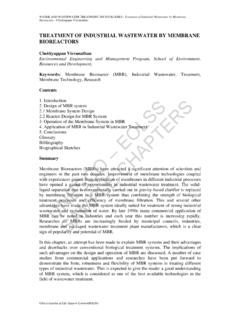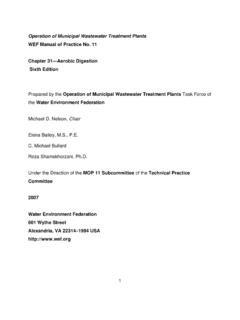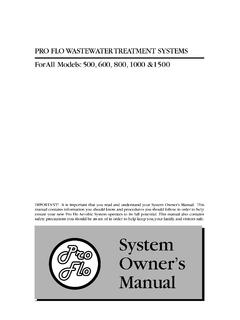Transcription of ATAD, The Next Generation: Design, Construction, Start-Up ...
1 ATAD, THE NEXT GENERATION: design , CONSTRUCTION, Start-Up AND OPERATION OF THE FIRST MUNICIPAL 2ND GENERATION ATAD James P. Scisson, Jr Finkbeiner, Pettis & Strout, Inc. One Lake Erie Center, Suite 400 Toledo, Ohio 43603 ABSTRACT Autothermal thermophilic aerobic digestion (ATAD) is an effective method to produce a pasteurized (Class A) biosolid. The process has not been well received in the United States because of problems with odors, poor volatile solids reduction, high dewatering costs and inflexible designs. An improved, 2nd generation ATAD design was developed to provide high total solids reduction in a small reactor for industrial biosolids. The improved design has solved the operating and aesthetic problems inherent in the first generation of ATAD. The new unit operates automatically, reduces the total solids by nearly 50%, dewaters well at a reasonable polymer dose with no metal salt addition required and produces no odors other than ammonia.
2 The original plan for solids handling was a dryer, which was quite expensive. Use of the 2nd generation ATAD allowed the use of a much less expensive dryer, which reduced capital and operating expenses. The use of a "dual A" process also eliminated costly redundant equipment. KEYWORDS 2ND generation ATAD, jet aeration, INTRODUCTION Autothermal thermophilic aerobic digestion (ATAD) is an effective method to produce a pasteurized (Class A) biosolid. The process has not been well received in the United States because of problems with odors, poor volatile solids reduction, high dewatering costs and inflexible designs. An improved, 2nd generation ATAD design was developed to provide high total solids reduction in a small reactor for industrial biosolids. The improved design has solved the operating and aesthetic problems inherent in the first generation of ATAD.
3 This paper will discuss the selection, design , Start-Up and operation of the first municipal 2nd generation ATAD, which was constructed in Three Rivers, Michigan in 2002. WEF/AWWA/CWEA Joint Residuals and Biosolids Management Conference and Exhibition 2003 Copyright 2003 Water Environment Federation. All Rights Reserved. THE PROBLEM The City of Three Rivers is a mgd primary/secondary WWTP with an design flow of mgd, and an annual average flow of about mgd. Solids handling consisted of anaerobic digestion, centrifuge dewatering, and landfilling. In 1998 the plant was continually exceeding its permit limits and emitted noxious odors, which caused a great public uproar and much agitation. A study found the following problems: The City had contracted to treat wastewater from a nearby village. The load was greater than expected.
4 The secondary treatment process could not handle the increased carbonaceous biochemical oxygen demand (CBOD) load. In addition, long detention times in the contract community force main caused odors at the plant. Large variations in organic loading occured from season to season Failing anaerobic digesters produced odorous sludge that did not always meet Class B pathogen requirements and was marginal for vector attraction reduction requirements (VARR). The WWTP accepted septage daily. The septage receiving station was less than 100 feet from residences and generated many odor complaints. The septage also contributed to the organic overload, ODORS, ODORS, ODORS. The sources of odors listed above were a primary complaint of the citizens. The problems above led to an administrative consent order from the Michigan Department of Environmental Quality (MDEQ).
5 As part of the consent order, the City agreed to increase the plant capacity, eliminate odors, and improve the solids handling HOW A 2ND GENERATION ATAD WAS SELECTED The solids handling train was studied because the existing digesters were in need of extensive repair and were not performing well. The study recommended that the plant abandon digestion, use the digesters as holding tanks and use an indirect dryer to produce an exceptional quality biosolid (EQB) that could be used without class B restrictions. Drying undigested solids in a continuous dryer posed several problems, including: Odors from the sludge holding tanks and dryer emissions. Additional energy (perhaps 25%)is needed to dry undigested solids, as more water is bound up within the bacterial cells. The continuous dryers might require periodic round-the clock campaigns to avoid excessive thermal stress on the equipment.
6 The Three Rivers WWTP is staffed 10 Campaigns would require extra labor cost. Sludge dryers are relatively expensive for the size of the plant. Budget prices for dryers were about $ million. WEF/AWWA/CWEA Joint Residuals and Biosolids Management Conference and Exhibition 2003 Copyright 2003 Water Environment Federation. All Rights Reserved. Because of the odor problems, a redundant centrifuge and dryer might have to be part of the capital improvements, making the project very costly for a city with a depressed economy. The above problems made it advantageous to stabilize the solids before drying, as odors and redundant equipment could be eliminated. After further study, a 2nd generation ATAD was selected to stabilize the solids which would be a combination of primary sludge, thickened waste activated sludge (TWAS) and screened, degritted septage combined in one holding tank.
7 The ATAD would be chained with a dryer for a Dual A biosolids process. The ATAD has many advantages, including: The process could be housed in two existing sludge storage tanks and the old sludge truck garage, reducing capital cost. All the moving parts were out of the tank The process uses reliable, low maintenance pumps and blowers to mix and aerate the sludge. All piping is stainless steel and fiberglass. The ATAD would reduce the total solids to be dewatered and dried by 40-50%. This mass reduction made it possible to use an inexpensive (approx. $325,000) indirectly heated batch drier. This chaining of two class A processes actually made the project less expensive to build and operate. (This will be the subject of another paper). It eliminated the need for redundant units, as the ATAD and centrifuge would produce EQB cake solids if the dryer were out of service, the ATAD would produce EQB liquid if the centrifuge were out of service, and the dryer would produce EQB biosolids if the ATAD were out of service.
8 No land application permits were required from MDEQ (Figure 1). Different types of biosolids would be produced for different potential end users. WEF/AWWA/CWEA Joint Residuals and Biosolids Management Conference and Exhibition 2003 Copyright 2003 Water Environment Federation. All Rights Reserved. Figure 1 Three Rivers Solids Handling Schematic WHAT IS AN ATAD? ATAD stands for Autothermal Thermophilic Aerobic Digestion. The ATAD consists of insulated reactor(s), a volumetrically efficient (low air flow) aeration system, foam control devices and transfer piping as required. The aerobic reactions in the digester release sufficient heat to raise the reactor temperature to the thermophilic range, generally from 56o-65o C. To comply with the EPA requirements for time and temperature the ATAD operates on a draw and fill cycle.
9 Hold times based on time and temperature range from 4-20 hours. ATADs have been used in the US almost exclusively to digest TWAS, thickened above 4% TS. The initial (first generation) ATAD designs are characterized by the following design and operating features (Figure 2): Aspirating air systems - hollow tube aerators, aspirated pumps or aspirated jet systems . 2 or three reactors operated in series Short SRT, generally less than 10 days for the whole series of reactors WEF/AWWA/CWEA Joint Residuals and Biosolids Management Conference and Exhibition 2003 Copyright 2003 Water Environment Federation. All Rights Reserved. Mechanical foam cutters protruding through the tank ceiling. An invariable air supply and no aeration control. This design has several shortcomings, and led to the following operating problems, which hindered the acceptance and use of this technology: Insufficient detention time, leading to poor VS reduction Poor temperature regulation, which requires the addition of heating and cooling loops in the reactors Figure 2 First Generation ATAD Schematic Insufficient flexibility in some designs.
10 The hollow tube aerator design requires a constant liquid level. The air must be shut off during the draw and fill cycle Insufficient oxygen delivery, leading to poor stabilization and ODORS, ODORS, ODORS. In some communities the odors became the focus of local elections. Extremely high polymer dose required for dewatering. ATAD sludge is composed of non-flocculent thermophilic organisms, has a high negative charge and a massive demand for cations to promote flocculation. At some installations the polymer cost exceeds $180/ton. The ATAD sludge does, however, dewater very well. The polymer dose can be reduced by the use of WEF/AWWA/CWEA Joint Residuals and Biosolids Management Conference and Exhibition 2003 Copyright 2003 Water Environment Federation. All Rights Reserved. large doses of iron or aluminum salts to satisfy the ATAD biosolids' demand for cations.


